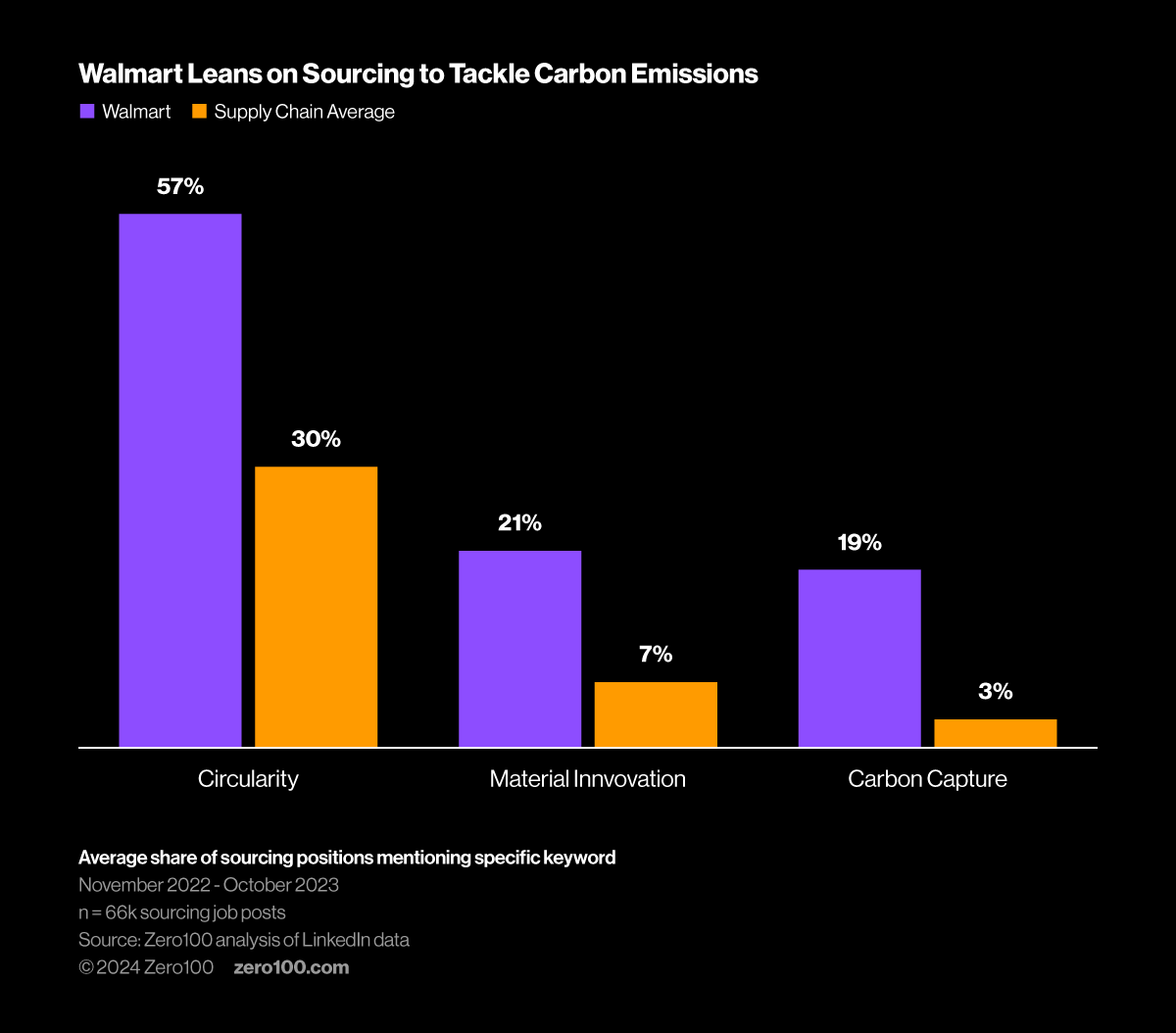

Walmart’s Project Gigaton: Sourcing and Supplier Focus Leads to Success
In 2017, Walmart launched Project Gigaton with the goal of reducing, avoiding, or sequestering one gigaton of carbon emissions across its entire value chain by 2030. They’ve hit their target – six years early. Walmart’s massive achievement is the result of aligned focus across the organization and within supply chain specifically, with a concentration on sourcing.
Key Takeaways
-
1
Walmart, one of the 34% of companies with a Scope 3 SBTi target out of our set of nearly 200 organizations, was the first retailer to have a target approved by the Science Based Target Initiative in 2016 and the 26th overall. Today, over 2,000 companies have targets across the Scopes 1, 2, and 3.
-
2
Looking at supply chain job posts overall, Walmart mentions the term “circularity” in 16% fewer posts than its peers. However, the term appears in 57% of Walmart’s sourcing posts (vs its peers at 30%). In addition, “material innovation” and “carbon capture” appear in three times as many Walmart sourcing posts as compared to the peer average.
A year and a half ago, Zero100 Co-Founder and Chief Research Officer Kevin O’Marah shared details on Walmart’s Gigaton PPA, the first-ever aggregated power purchase agreement. His assessment was that this was a great move, “not only because it makes renewable power easier to procure, but because it also ties decarbonization directly to making a big customer (ie Walmart) happy.” So, what exactly is Gigaton PPA? And how did it help Walmart, a massive retailer with tens of thousands of suppliers across the globe, hit their target of cutting one gigaton of greenhouse gas emissions in product value chains – six years early?
In 2017, Walmart launched Project Gigaton with the goal of reducing, avoiding, or sequestering one gigaton of carbon emissions from its entire value chain by 2030 by working closely with suppliers. Today, more than 5,900 suppliers have signed on to the project, making it one of the largest private sector consortiums for climate action. In October 2022, while hosting summits and providing tech tools to suppliers, Walmart, alongside Orsted and Schneider Electric, revealed perhaps the most decisive and influential step in their journey – convening the first cohort of suppliers to take part in a renewable energy accelerator: Gigaton PPA. Designed to help suppliers that had previously struggled to access renewable energy, the cohort had already helped over 250 Walmart suppliers, including Amy’s Kitchen, Levi Strauss &Co., and Smuckers, to access educational resources on renewable energy procurement when announced. Despite hitting their target early, Walmart is continuing Project Gigaton with the aim of hitting zero operational emissions (Scope 1 and 2) by 2040 and improving their approach to cutting Scope 3 emissions.
The key unlock within Walmart’s sustainability journey is sourcing – the function responsible for the most carbon emissions. Walmart has made a decisive effort to seek out talent with circularity skills/experience in sourcing roles, with 57% of their sourcing job posts mentioning circularity (compared to the peer average of 30%). As a pioneer in not only setting carbon reduction targets (they were the first retailer to commit to SBTi targets in 2016) but also achieving targets (Project Gigaton), this strategy has proven effective. The retail giant has also emphasized material innovation and carbon capture in their search for sourcing talent, specifying the former in 21% of roles vs 7% for peers and the latter in 10% of roles vs just 3% for peers. Along with recruiting for sustainability backgrounds, hiring for digital skills has proven to result in faster progress towards carbon targets. The more digital a company is, the more likely they are to be ahead on their SBTi targets – and those targets also tend to be more ambitious.

As the first retailer to set a Science Based Target in 2016, Walmart leaned (and continues to lean) heavily on science to guide their efforts, seeing it as the avenue through which to achieve significant and immediate but also scalable and sustainable results. The SBTi called approving Walmart’s target a “turning point” as the world’s largest retailer brought science-based targets to the mainstream.
So, what can we learn from Walmart’s success? Letting science be your guide to setting and tracking progress toward goals is an important step to ensuring your targets are both reasonable and sufficient. Next, align talent with purpose and value – recruit using specific language in the areas you are looking to bolster. Seek out material scientists and experts in circularity, material innovation, and carbon capture and leverage AI, particularly in sourcing, to drive efficiencies. Walmart’s massive achievement is the result of their aligned focus across the organization, within supply chain specifically, and with a concentration on sourcing.
To learn more about the retail giant’s unique approach to sourcing, listen to Andrea Albright, EVP, Sourcing at Walmart, discuss the company’s innovative practices on The Zero100 Podcast here.
To see a different data cut or to dig deeper into this topic, reach out to our Head of Research Analytics, Cody Stack, at Cody.Stack@zero100.com.
Methodology
Zero100’s proprietary data and analytics are a combined effort between our data scientists and research analysts. We provide data-first insights matched with our own research-backed points of view and bring this analysis to life via real-world case examples being led by supply chain practitioners today.
For this study, we looked at 2.8 million LinkedIn job posts from 175 B2B and B2C companies. Our analysis categorizes listings based on mentions of specific digital skills within job titles and descriptions.